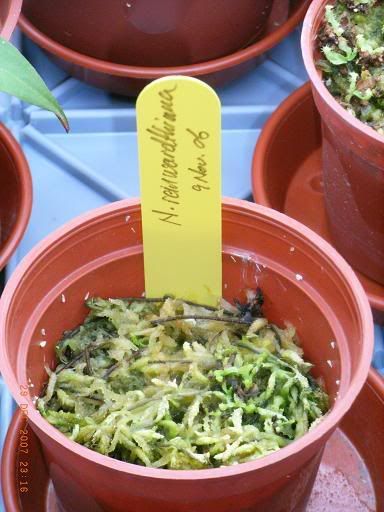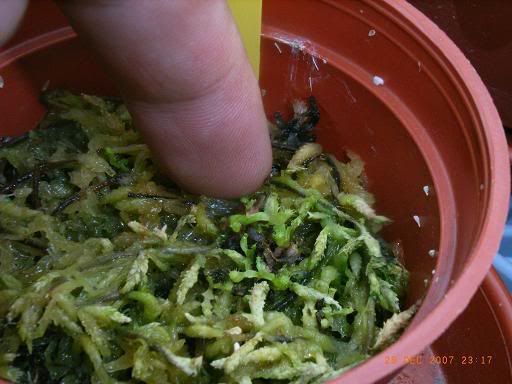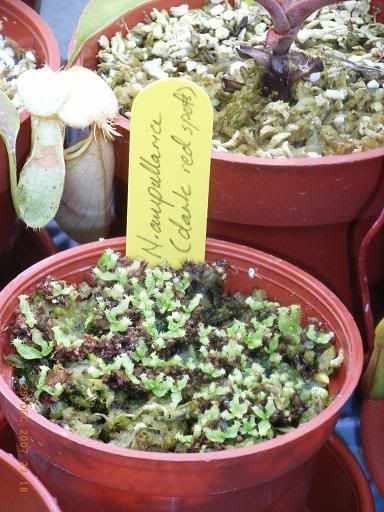|
|
Post by David on Jan 4, 2008 14:02:09 GMT 8
Need some advise here. I've got this pot of N. reinwardthiana and ampullaria plantlets grown from seeds 1 year ago. They were sown on 9 November 2006. It germinated within a month or so, but until now the size remains the same. It just does not want to grow. I have other seeds that have now become plants that are about 3 inches in diameter.  My finger in the pot to show how small they are after one year...  I also have a pot of N. ampullaria seeds that have germinated last year. Same fate...It just seems to have stopped growing and remains so tiny...  |
|
|
|
Post by ericsow on Jan 4, 2008 16:36:49 GMT 8
David, Not to surprise for me. Last year I had germinated a type of Nepenthe, some of same group people managed to grow they around one feet long of plant diameter. And now about 14 months ago, guess what is my nep size and specie is it? Smaller than five cent coin and it is N.mirabilis.  |
|
|
|
Post by isaacgoh on Jan 4, 2008 16:39:57 GMT 8
David,
I have the same batch of dark red spots amp seeds germinated too. Mine has grown to 2 inches in diameter with about 1cm pitcher for the biggest plantlet.
I grow mine in sealed terrarium.
Thanks.
Rgds,
Isaac
|
|
|
|
Post by ameliepoulain on Jan 4, 2008 20:18:16 GMT 8
:off topic:
David, is that a white raff. I see in the background of the 3rd photo?
|
|
|
|
Post by cindy on Jan 4, 2008 21:26:56 GMT 8
David, It is an open secret. Fertilise them at quarter strength on a weekly or biweekly basis.  |
|
|
|
Post by rainforestguy on Jan 5, 2008 11:13:09 GMT 8
Thank you Cindy! But seeing the media, I would say that LFS is a poor choice for a media for nepenethes seedlings with which you want to use a fertilizer on, as it breaks down too rapidly so roots never get a good foot hold for speedy growing. Here is a shot os some seedlings about five months old and I use Peter's fertilizer at quarter strength every few weeks, especially after a heavy rain.  This is recently obtained N. rafflesiana seed. Please note I use rotted coco chips well aged and "dirty" for best germination and growth. M |
|
|
|
Post by phissionkorps on Jan 6, 2008 4:38:18 GMT 8
I agree about LFS not being good for starting seedlings. Also, even if I nuke it, LFS is the onlymedia which somehow randomly sprouts plants I've never seen before, which quickly overtake the seedlings.
Michael,
I've been thinking about it for a while, and looking at your media choice....
Based on some experiments, we can with some certainty say that gibberellins don't play too large a role in Nepenthes germination. Do you think that bacteria is wholly or at least majorly responsible? I have a feeling it is. I also notice faster germination when my seedlings get covered with algae, which might just be coincidental.
|
|
|
|
Post by rainforestguy on Jan 6, 2008 8:52:36 GMT 8
Its really odd that seed that just falls from a seed pod to a pot (usually with a larger nepenthes growing in it) tend to germinate and become "seedling" in appearance much faster than these seeds germinated on somewhat fresh media. I especially like old used media with it being well rotted and composted to germinate my seeds on. The "old" media seems to make plants just take off.
Has anyone else noticed how these volunteer seedlings just appear with well developed leaves and pitchers much faster than those well cared for and fertilized on selected media?
M
|
|
|
|
Post by David on Jan 6, 2008 23:34:46 GMT 8
Thanks everyone for your coments. Some questions:
Cindy, what fertilisers do you use?
Mike, the media for your seedlings... is it wood chips? Do you mix it with something else?
Isaac and Eric, what is the media that you guys use when germinating your seeds?
|
|
|
|
Post by David on Jan 6, 2008 23:36:13 GMT 8
:off topic: David, is that a white raff. I see in the background of the 3rd photo? Yes Athene, it's a white raff with frilled tendril. Still small so can't see the frilled tendril.  |
|
|
|
Post by rainforestguy on Jan 7, 2008 2:59:07 GMT 8
The media I am using here is old used coco bark after it begins to break down. Hey there is a use for coco chips after all! By the time they are ready for transplanting, the coco has broken down and lost all consistency as a stable media. This if fine since by now you are more interested in using a good media that will hold up for as long as possible. Straight coco bark will decompose too rapidly and cause too many root related problems for many plants later in life. Even those who use coco straight need to constantly replace this media regularly otherwise they will cause many problems for nepenthes later on. This media is good because when it breaks down, it makes for easy transplanting to individual pots. The regular mix would be a fine bark, perlite and some peat moss media. The peat moss helps stabilize the nutrient up take of fertilizers, but usually don't use it after the plants take a hold.
Larger plants I usually use a compost blend and fine bark, perlite, cinders and whatever else is available.
M
|
|
|
|
Post by isaacgoh on Jan 7, 2008 11:35:04 GMT 8
Isaac and Eric, what is the media that you guys use when germinating your seeds? David, I use normal sphagnum moss. Btw, I suspect the plantlets from the dark red spots seeds are not pure ampullaria, could be hybrid because the pitchers look longish, have to observe longer to confirm. Rgds, Isaac |
|
|
|
Post by cindy on Jan 7, 2008 21:24:16 GMT 8
David, I use Orchid fertiliser at a quarter strength. Works miracle on seedlings.  |
|
|
|
Post by David on Jan 7, 2008 22:48:09 GMT 8
Hi Mike,
When you say coco bark, do you mean coconut tree bark or bark from the coco plant? I always get confuse when people say this. Don't know if they mean coco or coconut. It should mean coconut bark right?
Thanks Cindy and Isaac for your explaination.
|
|
|
|
Post by rainforestguy on Jan 8, 2008 6:37:29 GMT 8
coco as in coco nut husk. We get it in a medium, small and a very fine called coir/coco peat.
I don't particularly like this media as it is very salty and for some species do cause some reduction of growth or keeps them from growing well. This media is best used when about a couple of months old, then it turns to mush and may be detrimental to some after a while.
The best media is one that drains freely as this usually encourages good symbiotic relations between plant and microorganism.
M
|
|
|
|
Post by David on Jan 8, 2008 8:45:03 GMT 8
Thanks Mike.
|
|
|
|
Post by primavera on Jan 11, 2008 3:03:33 GMT 8
Just a couple of thoughts:
The faster growth rate on old media/base of established plants could be attributed to mycorrhizal fungi. These fungi form symbiotic relationships with the plant through its roots, helping the plant to absorb nutrients/fight pathogens (pests) better.
Orchids germinate via such symbiosis in nature. When orchidmania hit Europe in the 1800s, they had difficulty getting seeds to germinate and grow, probably because the seeds were so tiny with little endosperm (food reserves for it to grow). Then someone sowed seeds on the base of the mother plant and they germinated. These jungle collected plants probably had their mychorrhizal partners still intact, which helped in germination.
Now, similarly, nepenthes seeds are also tiny, with little endosperm, and when germinated, little root mass. Presumably they also need mycorrhizal partnerships to grow better. Therefore sterile media such as dried sphagnum moss or perlite would not work as well as live sphagnum in my opinion, which probably already have some mycorrhizal species present. I've seen fast growth rates when transplanted to live sphagnum, and I've recently been trying with other types of moss such as the common Singapore moss (Vesicularia dubyana).
Another thing about coconut husk chips is its tendency to become soggy and airless. I think for this media to work well for seedlings, one has to provide some circulation and fresh air to prevent it from being overtaken by unwanted fungus. Michael, do you keep your pots in an airy place? I think sphagnum and mosses in general have a slight antiseptic property against pathogens.
Also as Michael has pointed out, some coconut husk chips can have varying concentrations of salt, which is detrimental to nepenthes. This depends on which area they are harvested in, as some coconut plantations are next to the sea, and might be exposed to salinity. I tend to veer on the safe side and leave my new coco chips in pots soaking with rain water, and then draining and soaking again. They are a wonderful media for established nepenthes when they break down a bit.
With fertiliser, try to use one with little or no urea. Orchid fertilisers fit the bill perfectly as the nitrogen source are mostly nitrate/ammonia. Also, try to flush the pot out with rainwater/RO water after several fertilisations to prevent salt build-up.
|
|
|
|
Post by David on Jan 11, 2008 9:09:54 GMT 8
Thanks primavera for the information. Appreciate it.
|
|
|
|
Post by isaacgoh on Jan 11, 2008 12:29:19 GMT 8
The information that orchid needs bacteria in the media to grow well sounds perfectly logical to me.
Good bacteria in the soil column is important even in aquarium planted tanks. So why not terrestial plants?
|
|
|
|
Post by primavera on Jan 11, 2008 19:51:14 GMT 8
You are welcome David. Issac, bacteria plays a big part in soil health, but the symbiotic relationship that I refer to is specifically with fungi (mycorhiza), and not bacteria. These fungi actually infiltrate the cells of the orchid roots, gaining carbohydrates and proteins that the plant makes, but in return, absorbing nutrients from the surrounding environment for the orchid. As orchids have a small root system, the fungus - with its extensive hyphae/mycelia (those fluffy white strands you see growing over soil), actually increases the surface area of nutrient absorption for the plant when they attach to the roots. There is a suspicion that in fact most (80% or something) trees in the tropics, with its thin, poor soil, actually have symbionts of mycorrhiza to help with nutrient absorption. It is my suspicion that with so many neighbouring plants , especially in poor kerangas or moss forest with mycorrhiza associations, why not nepenthes? Also, at least with the nepenthes I grow, not sure about in nature, I seem to notice a small root mass in relation to the plant, and perhaps this calls for fungi help too  |
|